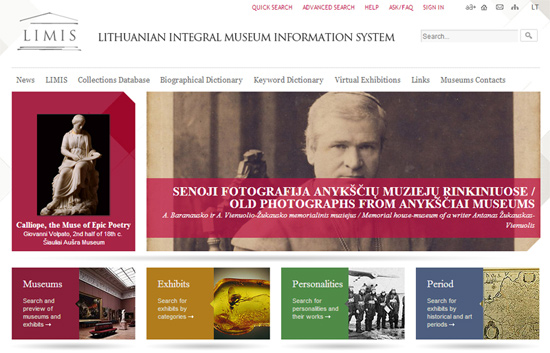About LIMIS
 With the acceleration of digitisation processes in Lithuanian museums and their growing number of digital collections the question about the integrity and homogeneity of such content arise. The objective behind the Lithuanian Integral Museum Information System (LIMIS) is to unify the standards of collections descriptions and operational ontologies (classifiers, thesauruses, dictionaries) that are necessary for the digital content to be preserved and widely represented. LIMIS will describe the integral data model for museum objects and the principles of the use of ontologies. It will also define the ways of presenting cultural content to the end-users and sharing it with external portals.
With the acceleration of digitisation processes in Lithuanian museums and their growing number of digital collections the question about the integrity and homogeneity of such content arise. The objective behind the Lithuanian Integral Museum Information System (LIMIS) is to unify the standards of collections descriptions and operational ontologies (classifiers, thesauruses, dictionaries) that are necessary for the digital content to be preserved and widely represented. LIMIS will describe the integral data model for museum objects and the principles of the use of ontologies. It will also define the ways of presenting cultural content to the end-users and sharing it with external portals.
Based on the Strategy of Digitisation of Lithuanian Cultural Heritage, Digital Content Preservation and Access, the development of LIMIS has been initiated. The system would enable automation of the stocktaking of museums holdings, aggregation of the databases of Lithuanian museums into the common repository and representation of the preserved cultural heritage values integrally and worldwide. One of the aspired results of the system is a joint public catalogue intended for museum specialists working with museum exhibits (archivists, conservators, researchers, curators, etc.) and for registered users (public officers, scholars, etc.). Information for public users will be available on the LIMIS database or electronic catalogues accessed through www.limis.lt portal and museums’ websites respectively. The system will enable museums to not only send data about their exhibits to the integral museum information system but also to make their own electronic catalogues, provide free access via internet and make virtual exhibitions from the data aggregated in museums’ electronic catalogues. In addition, they will be able to take part in other digitisation projects and to independently provide their project partners with the data on their digitised exhibits.







